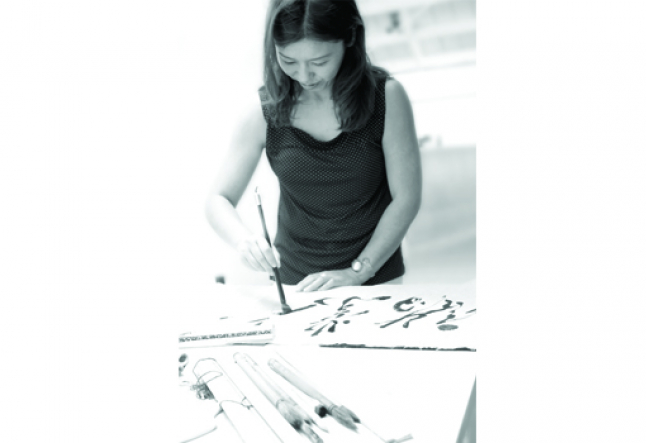miho hagino | the word weaver

a japanese calligrapher in los angeles
There are two old sayings in Japan that are often referred to in the shodo (Japanese calligraphy) world: “Kokoro tadashikereba fude tadashi,” which means that a brush without the correct mental attitude creates superficial characters or images that lack strength. Another is, “Seishin toitsu,” which means the spirit (and mind) is gathered; the myriad distractions are gone and all that remains is the self, focused and attentive on the here and now. All is equal and in harmony and this transcends all.
This is perhaps where shodo (or sho) differs from the Western art of calligraphy. Though both are beautiful expressions of language, in sho, lines cannot be added or fixed; one brush stroke is everything, and because of that, it requires tremendous focus.
With the influence of her mother, who was also a calligrapher, Hagino Miho began practicing shodo at the age of three. At sixteen, the Shosen Shodo Association in Japan granted her the title of shihan, a master of Japanese calligraphy. Shortly after however, she withdrew from the practice having lost sight of the purpose behind her art.
“At that point, I still couldn’t understand the beauty of sho or its Zen-like aspect. I thought it was just boring and hard work. I also had a question about the old way of Japanese shodo associations and how they seemed to be more about matters of money and power rather than the beauty and possibility of sho itself.”
“However, as I aged and experienced more things in life, little by little I started to understand the great value of sho and started to see its beauty and the calligrapher’s state of mind in their lines and compositions. Now I feel that this is one of the most wonderful arts that one can use to connect to the spirit and even to the universe.”
Many people see sho as the expression of one’s ki or internal spirit. Sho allows the dynamic movement of the artist’s spirit to become observable in the form of rich black ink. In sho, you can sense both the rhythm of music as well as the smooth, elegant, balanced and sometimes very experimental construction of architecture. The brush strokes reveal the state of body and subconscious mind of the calligrapher. In genuine sho, the mind is vividly present and to endow the characters with life, the calligrapher not only has to master the brush technique but more importantly, train the mind.
“I don’t really know what inspires or influences me when I am doing sho, but each brush stroke and each depth of ink truly shows my mental state at the time,” Miho says. “When I can clearly concentrate, it feels like a meditation and I’m becoming calm but at the same time my senses are sharpened. In that moment I feel connected to the universe. This moment rarely occurs; maybe once every few years, but feels great.”
Traditionally, sho was seen in temples, shrines and in the tokonoma (alcove used to display art and treasured possessions) in Japanese homes. As a result, temples are where most people learned the art. Today, it can be seen everywhere. In Western-style houses it is displayed in the same way as pictures, posters and photographs are. It’s also seen in the reception areas of companies, in restaurants and hotels, and even used as logos, brand marks and so on.“My goal is to create sho pieces where others as well as myself can feel harmony with this universe. I’d also like to spread the beauty of sho in Western culture as an art that is connected to the spirit, not as merely writing Chinese or Japanese characters beautifully.”
Read next >> interview with dave stringer